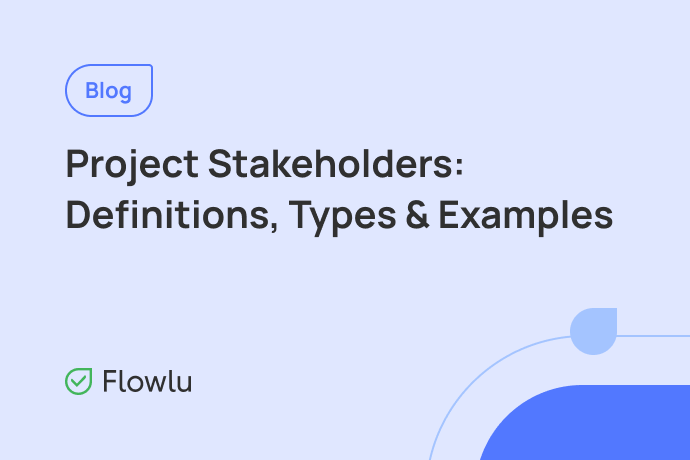What is a Work Breakdown Structure?
The WBS includes all steps necessary to achieve the project objective and helps you understand the extent of work better. WBS might be presented with different visual variations which include tree structure, tabular view, outline view, chart and more.
Why Do You Need WBS?
Work Breakdown Structure is an extremely useful tool for project planning. Here is why:
WBS helps you to visualize and estimate the entire project scope. It helps you at a glance view the amount of work required to complete a project and ensures nothing is skipped in the process of project implementation.
It helps you assess costs and time of work. WBS allows you to quickly find out if your project might exceed the planned budget or deadline. By dividing a project into small components, it’s easier to estimate the costs and time involved based on planned tasks.
Using the WBS, you can easily allocate human resources. As every task is assigned a teammate, you’ll easily see how many team members you require. This helps estimate the staff you will need for the project.
The WBS gives teams an overview of their responsibilities. With the Work Breakdown Structure, your teammates have a better idea of what is expected from them and what must be done to achieve the end goal.
The work breakdown structure helps to reduce the probability of changes and mitigate risks. As you’re creating a WBS before a project is being executed, you are reducing the chance of any unexpected events by clearly pointing out all the tasks that are required to complete the project.
The WBS gives you full transparency over the project progress. This way you can track the status of each project part with ease to avoid missing deadlines and ensure that every piece of work is performed on time.
Different Forms of Work Breakdown Structure
You can organize the work breakdown structure in several ways:
By phases of the project lifecycle, for example, initiation, planning, execution, approval, closing. This is the simplest and most popular approach, especially if the project follows an approved workflow and it is clear to everyone what should be the outcome at each phase.
By project high-level deliverables. In this case, a project is broken down into main outcomes, for example, new equipment, user manual, product prototype, signed contracts, etc.
By project responsibilities, for example, production, marketing, testing team, etc. This approach suggests that you define project activities based on the company’s teams that will work on the project.
By deadlines, for example, by quarters, months. You can apply this method if the time or deadlines are the most critical part of the project. The times-based approach is usually used on very long projects.
How to Create a WBS
1. Establish a Project Objective
Examine your project plan and establish the project objective. This is a goal you want to achieve by completing the project. The project objective goes at the top of your work breakdown structure.
2. Identify High-Level Deliverables
When you have determined the main objective, brainstorm with your project team, and enumerate what you’ll need to do to meet your project’s end goal. For instance, to create a mobile app the main stages might include:
- Wireframes
- Infrastructure
- Design
- Development
- Testing
- Launch
3. List Milestones
Once you’ve identified the high-level deliverables or stages for your project, examine what milestones need to be achieved to create this deliverable. Milestone focuses on major progress points in a project and is used to simplify the monitoring of the stage’s progress. Using the mobile app development as an example, you might break up the “Wireframes” deliverable:
- User and Market Research
- Drafting
- Wireframe Building
- Prototyping
- Testing
4. Break Out Tasks
You need to make your work breakdown structure as specific and comprehensive as you can. The best choice is to study every milestone you’ve specified and determine the tasks that need to be done to achieve these milestones. Using the the “User and Market Research” milestone you can set the following tasks:
- Explore User Personas
- Examine Possible User Journey
- Determine Use Cases
5. Provide Details
Include short descriptions of stages, milestones and tasks to give the project team directions. Use notes to collect your thoughts and observations. You might also estimate how long each task might take.
6. Assign Teammates
When all the information is filled out, define team members’ responsibilities by allocating pieces or work to them. If you’re using a project management tool like Flowlu, you can easily assign the milestones and tasks to each person. This way, you can ensure that nothing is ever missed out.
Best Practices
Nouns and Adjectives Instead of Verbs
Each work package, or set of related tasks, in a WBS is not an action. It is a deliverable which represents a final product or service. It should identify the reason for doing something, not the ways to achieve it. A deliverable can be created by any actions. They might be modified during project execution, but the deliverable remains unchanged. That’s why you need to use nouns and adjectives instead of verbs to define work packages.
Include Everything
Ensure that every project part is complete and nothing is missed out. The work breakdown structure should contain 100% of the work specified by your agreement with the customer. You need to capture all deliverables and tasks, even the tiniest ones. But be careful not to get too specific as it might eventually become confusing to manage such a project. Ideally, create up to five levels.
Levels Follow a Hierarchy
A work breakdown structure starts with a project or the main objective, which is then divided into high-level deliverables and then into milestones and tasks. The WBS should be logical, clear and easy to grasp. Each component should be an independent piece of work. The sum of all the child components should always give you the parent element.
Use a PM Software
Most project management tools have built-in capabilities to help you easily create a work breakdown structure for each project. Such software as Flowlu also allows creating project workflows with the pre-defined work structure. In the workflow, you can specify stages, milestones, and a set of standard tasks so you can free yourself from repeatedly creating the same projects from scratch.
Summing Up
The breakdown work structure is a simple and helpful way to plan almost any complex project. Using WBS helps you to better visualize project scope, estimate time and costs involved, mitigate risks, keep your team organized, and always have a clear picture of your project progress.
A Work Breakdown Structure (WBS) is a visual, hierarchical representation of project deliverables that organizes the project's scope into smaller, more manageable parts in terms of size, responsibility, and duration. It includes all steps necessary to achieve the project objective and helps in better understanding the extent of work.
To create a WBS, first establish the project objective, identify high-level deliverables, list milestones for each deliverable, break out specific tasks needed to achieve these milestones, provide details for stages, milestones, and tasks, and assign team members to each task.
A Work Breakdown Structure can be organized in several ways, including by phases of the project lifecycle (e.g., initiation, planning, execution), by project high-level deliverables (e.g., new equipment, user manual), by project responsibilities (e.g., production, marketing, testing team), or by deadlines (e.g., by quarters, months).











